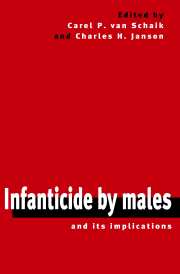Book contents
- Frontmatter
- Contents
- List of Contributors
- Foreword
- Infanticide by males: prospectus
- Part I Introduction
- Part II Infanticide by males: case studies
- 4 Infanticide in red howlers: female group size, male membership, and a possible link to folivory
- 5 Infanticide in hanuman langurs: social organization, male migration, and weaning age
- 6 Male infanticide and defense of infants in chacma baboons
- 7 Infanticide by males and female choice in wild Thomas's langurs
- 8 The evolution of infanticide in rodents: a comparative analysis
- 9 Infanticide by male birds
- Part III Behavioral consequences of infanticide by males
- Part IV Infanticide by females
- Part V Conclusion
- References
- Species index
- Subject index
9 - Infanticide by male birds
Published online by Cambridge University Press: 04 November 2009
- Frontmatter
- Contents
- List of Contributors
- Foreword
- Infanticide by males: prospectus
- Part I Introduction
- Part II Infanticide by males: case studies
- 4 Infanticide in red howlers: female group size, male membership, and a possible link to folivory
- 5 Infanticide in hanuman langurs: social organization, male migration, and weaning age
- 6 Male infanticide and defense of infants in chacma baboons
- 7 Infanticide by males and female choice in wild Thomas's langurs
- 8 The evolution of infanticide in rodents: a comparative analysis
- 9 Infanticide by male birds
- Part III Behavioral consequences of infanticide by males
- Part IV Infanticide by females
- Part V Conclusion
- References
- Species index
- Subject index
Summary
Introduction
The killing of dependent young individuals by conspecifics, what ecologists have called infanticide, has been viewed as one extreme and dramatic consequence of selection favoring those behaviors that promote the direct fitness of perpetrators (e.g., Hamilton 1964a,b). However, the evolutionary scenarios of this behavior may differ considerably depending on the identity of the perpetrators. It has been proposed that infanticide by non-kin is fundamentally different from infanticide by kin, which emphasizes the fact that the latter involves the sacrificing of shared genes for some presumed compensating benefits to the perpetrator's inclusive fitness (O'Connor 1978; Mock 1984). This infanticide by kin can be further subdivided into parental infanticide, i.e., the killing of young is committed by their own parents, and siblicide, the term used when the killing is carried out by full or half-siblings. The incidence of siblicide in taxa other than birds is, however, practically unknown (see Mock 1984). Four functional hypotheses have been proposed by Hrdy (1979) to explain the different types of pay-offs that may accrue to infanticidal individuals. In other words, infanticide should have evolved in the following contexts: (1) the exploitation of the infant, mainly as a food source; (2) resource competition, either with the infant or with its parents; (3) parental manipulation, wherein the parents interrupt their investment in the offspring to maximize their reproductive success; and (4) sexual selection, wherein infanticide increases the success of killers in intrasexual competition for mates.
- Type
- Chapter
- Information
- Infanticide by Males and its Implications , pp. 198 - 220Publisher: Cambridge University PressPrint publication year: 2000
- 13
- Cited by

